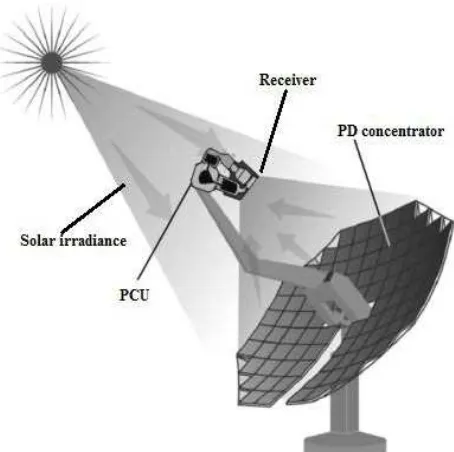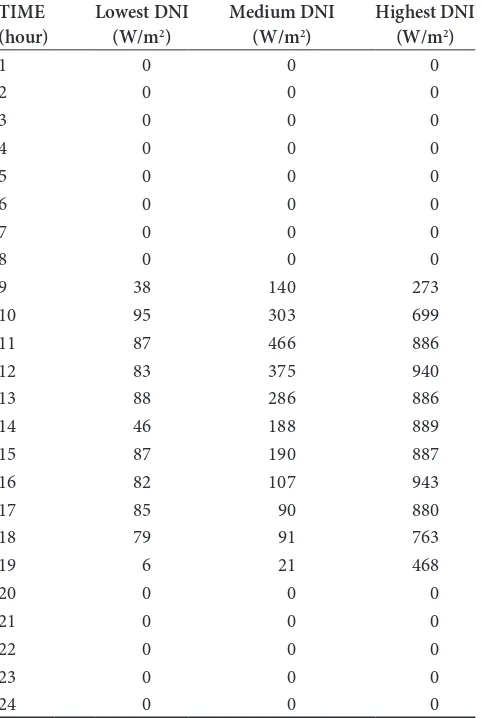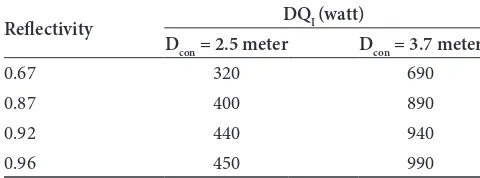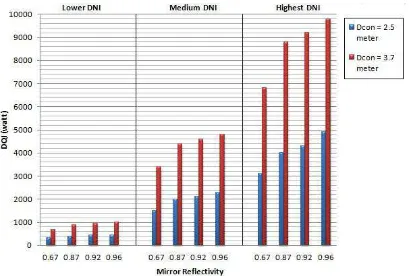The Inluence of Concentrator Size,
Relective Material and Solar Irradiance
on the Parabolic Dish Heat Transfer
Mohd. Ruddin Ab Ghani
1*, Rosnani Afandi
1, Chin Kim Gan
1, Siti Hajar Raman
1and Jano Zanariah
21Faculty of Electrical Engineering, Universiti Teknikal Malaysia Melaka, Melaka, Malaysia; dpdruddin@utem.edu.my
2Centre for Languages and Human Development, Universiti Teknikal Malaysia Melaka, Melaka, Malaysia
Abstract
Concentrating Solar Power (CSP) can meet the clean energy needs for power generation at a cost-competitive rate. Among the CSP technologies, Parabolic Dish (PD) has demonstrated the highest energy conversion efficiency. PD system produces electricity by using solar energy that is transferred from concentrator to receiver, to drive a Stirling engine and the gen -erator. The concentrator in a PD system is used for focusing the solar radiation into the aperture of the receiver that is integrated in the Stirling engine.Stirling engine then converts the absorbed solar energy from the receiver into mechanical power by expanding the working gas in the cylinder. Then, the Stirling engine converts a linear motion into a rotary motion to turn the generator and produce electricity.This study is carried out to analyze the effect of the size, reflecting material and the solar radiation or Direct Normal Irradiance (DNI) to the rate of heat transfer from the concentrator to the receiver in the PD systems. For this purpose, a Matlab Simulink was used, in which the different rate of DNI in George Town, Penang Malaysia were taken into account. The study showed that the rate of heat transfer for the PD systems depended greatly on the size, reflecting material and the DNI of the area. These results are useful to help a better understanding of the relation -ship between size and reflecting material to the rate of heat transfer for a PD system under different DNI level.
1. Introduction
Concentrator in PD system is used for focusing the Direct Normal Irradiance (DNI) onto the receiver. Generally, in analyzing the operation of the PD concentrator, three parameters need to be considered. he param-eters are: dish aperture size, relectivity material and the irradiance1,2. Currently, the diameter range for PD
concentrator that has been used in commercial plant is between 8-15 meters1. However, the size of PD
concen-trator depends on how much input power of the Power Conversion Unit (PCU) for the PD systems can handle. Furthermore, Mendoza3 argues that in order to transfer
the heat to the receiver as well as to reach high operating temperature at the focal point, the geometric design for the concentrator has to be optimized.
Generally, PD concentrator consists of a mirror that typically was arranged in a parabolic shape. Meanwhile, the quality of a mirror concentrator is measured by its relectance. Relectance is a percentage of incident sun-light that can be relected from the concentrator surface. Diferent materials can be used for relective surface. However aluminum or silver are the most common materials that have been used since centuries as eicient mirrors concentrator in a PD system4–7.
Meanwhile, all CSP technologies including PD sys-tems depend on the intensity of solar radiation8–10.
herefore, it can be said that the potential of a PD systems is largely determined by the solar radiation. According to Muhammad-Sukki et al.11, the world is estimated to
receive approximately 1000W/m2 amount of solar
irra-diation in a day whereas PD systems require at least
Indian Journal of Science and Technology, Vol 7(9), 1454–1460, September 2014
ISSN (Print) : 0974-6846 ISSN (Online) : 0974-5645
*Author for correspondence
1900–2000 kW/m2/year of Direct Normal Irradiance
(DNI) to be economic11.
On the other hand, in terms of the technical feasi-bility; it is essential to ensure that the PD concentrator can transfer the heat to the receiver as well as generate operating temperatures at the focal point at least 250°C to as high as 1500°C12–15. Furthermore, previous research
has revealed that the concentrator with a better relec-tance has a signiicant role in helping the PD systems transfer the heat to the receiver, attain high temperature as well as higher eiciencies7,16,17. herefore, the purpose
of this study is to provide a better understanding of the relationship between size and relecting material to the rate of heat transfer for a PD system under diferent DNI level.
2. Methodology
his study used a simulation approach using Matlab Simulink. he study focused on the conversion of solar energy to the heat energy transfer from the concentrator to the receiver in a PD system. he study of this simula-tion will help to better understand, especially the system interactions among concentrator and receiver subsystems in the PD system. he schematic diagram of a PD system is shown in Figure 1.
2.1 he Parameters Involved in the Heat
Transfer from the Concentrator to the
Receiver
In a PD system, the solar radiation that is focused to the concentrator will produce heat from the concentra-tion process. he heat then will be used for the energy conversion process. he rate of heat transfer from the concentrator to the receiver can be approximated by using an equation:
DQI= D I
æ è
ç öø÷
p con 2
2
r (1)
Dcon is the size of the concentrator, ρ is relective of the concentrator and I is the solar irradiance or DNI. herefore, size, relective material and the irradiance are the parameters that are important in determining the value of heat transfer from the concentrator to the receiver.
2.1.1 Size of the Concentrator
he diferent size of concentrator afects the rate of heat transfer to the receiver. 1kW PD system was used for this study and sizes of 2.5 and 3.7 meters were recommended for the concentrator7. he diferent sizes were used to
ana-lyze the efect of the concentrator size to the rate of heat transfer from concentrator to the receiver of 1kW PD system.
2.1.2 Relective Material
he diferent type or material that is used for the PD concentrator has diferent relectivity2,19,20 (see Table 1).
Generally, the concentrator is protected by either a pro-tective sheet of glass or plastic21 and consequently, when
the solar radiation passes through the concentrator, part of the solar radiation will be absorbed. he absorption of the solar radiation by the protective sheet can signiicantly reduce the solar energy that is transferred to the receiver. herefore, a clean and smooth relecting surface is required for a PD concentrator for the dust particles could
Figure 1. Schematic diagram of a PD system18.
Table 1. Relectance of the Concentrator
Material Relectivity (%)
Stainless steel 67
Iron sheet 87
Aluminium 92
The Inluence of Concentrator Size, Relective Material and Solar Irradiance on the Parabolic Dish Heat Transfer
scatter away the solar radiation from the receiver. Apart from that, the solar radiation could be partly absorbed by a thin dust particles on the concentrator surface.
In the present PD designs, mirror relectivity that has been used is in range of 91–95%19. However, among the
material used for the concentrator, silver is the preferred relector material with aluminium second1,7,16,22–24.
2.1.3 Solar Irradiance or Direct Normal
Irradiance (DNI)
he input DNI data for George Town, Penang, Malaysia is used as the input data for the simulation10. he DNI
data were downloaded from U.S Department of Energy website. Figure 2 shows the annual DNI data for George Town, Malaysia. From the data, the highest DNI was on 14 March with value of 943 W/m2, Medium DNI was
on 9 May with value of 466 W/m2, while lowest DNI was on
4 August with value of 88 W/m2.
Overall, the total highest irradiation was in February, followed by March, January, June, May, April, December, November, July and September. Meanwhile, the value for DNI in August and October throughout the month was below 200 W/m2. Several days in January, August and
December showed the DNI value of below 200W/m2.
he DNI value for 24 hours period for George Town, Penang, Malaysia is shown in Table 2. he lowest DNI value is shown in Figure 3, medium value in Figure 4 and the highest value in Figure 5. However, the rate of heat was taken and analyzed using 4 input DNI data in which the highest DNI is 943 W/m2 for the simulation purpose.
Two data during Medium DNI showed 466 W/m2 and
200 W/m2, while the lowest DNI is 88 W/m2.
3. Operational Framework
Simulation for the rate of heat transfer from the concentra-tor to the receiver in a PD system requires a few external inputs such as: concentrator size, relective material, and the solar irradiance or DNI. Refer to Figure 6.
4. Simulation Result
Tables 3–6 show the simulation result for the rate of heat transfer in a PD system by using 2 diferent sizes of con-centrator, 4 diferent relective materials and 4 diferent DNI data in George Town, Penang, Malaysia. From the table, the rate of heat transfer from the concentrator to the receiver for 2.5 meter concentrator during low DNI
(88 W/m2)was 320 to 450 watts; during DNI 200W/m2
was 620 to 850 watts; during medium DNI (466 W/m2)
was 1500 to 2300 watts and during highest DNI (943 W/2)
was 3100 to 4900 watts.
Meanwhile, the rate of heat transfer from the concen-trator to the receiver for 3.7 meter concenconcen-trator during low DNI (88 W/m2) was 690 to 990 watts; during DNI
200W/m2 was 1400 to 1900 watts; during medium DNI
(466 W/m2) 3400 to 4800 watts and during highest
DNI (943 W/m2) was 6800 to 9800 watts.
From the simulation result, the lowest value for the rate of heat transfer was 320 watts. he result was for 2.5 meter concentrator, using stainless steel as the relective material and during lower DNI data at George Town, Penang. Meanwhile, the rate of heat transfer for 3.7 meter concentrator, for stainless steel relector under low DNI level was 690 watts.
he highest value for the rate of heat transfer from the concentrator to the receiver in the simulation was 9800 watts. he value is for 3.7 meter concentrator, using silver as the relective material and high DNI data which was 943 W/m2. However, the highest value for the rate
of heat transfer was 850 watts, for DNI 200 W/m2, using
2.5 meter concentrator and silver as the relective mate-rial. Meanwhile, the highest value for the rate of heat transfer for DNI 200 W/m2, using 3.7 meter concentrator
and silver as the relective material was 1900 watts. Based on the results, with 3.7 meter concentra-tor, DNI 200 W/m2 is the lowest DNI input data that
Table 2. DNI value in 24 hours data for George Town, Penang, Malaysia
TIME (hour)
Lowest DNI (W/m2)
Medium DNI (W/m2)
Highest DNI (W/m2)
1 0 0 0
2 0 0 0
3 0 0 0
4 0 0 0
5 0 0 0
6 0 0 0
7 0 0 0
8 0 0 0
9 38 140 273
10 95 303 699
11 87 466 886
12 83 375 940
13 88 286 886
14 46 188 889
15 87 190 887
16 82 107 943
17 85 90 880
18 79 91 763
19 6 21 468
20 0 0 0
21 0 0 0
22 0 0 0
23 0 0 0
24 0 0 0
The Inluence of Concentrator Size, Relective Material and Solar Irradiance on the Parabolic Dish Heat Transfer
Figure 4. Graph for Time (Hour) versus irradiance (DNI) for medium DNI data in George Town, Penang, Malaysia.
Figure 5. Graph for Time (Hour) versus irradiance (DNI) for highest DNI data in George Town, Penang, Malaysia.
Table 3. Result for the rate of heat transfer in PD systems for lowest DNI level by using 2.5 and 3.7 meter concentrator and diferent type of relective material
Relectivity DQI (watt)
Dcon = 2.5 meter Dcon = 3.7 meter
0.67 320 690
0.87 400 890
0.92 440 940
0.96 450 990
Table 4. Result for the rate of heat transfer in PD systems for 200W/m2 DNI level by using 2.5 and
3.7 meter concentrator and diferent type of relective material
Relectivity DQI (watt)
Dcon = 2.5 meter Dcon = 3.7 meter
0.67 620 1400
0.87 800 1700
0.92 820 1800
0.96 850 1900
Table 5. Result for the rate of heat transfer in PD systems for medium DNI level by using 2.5 and 3.7 meter concentrator and diferent type of relective material
Relectivity DQI (watt)
Dcon = 2.5 meter Dcon = 3.7 meter
0.67 1500 3400
0.87 2000 4400
0.92 2100 4600
0.96 2300 4800
Table 6. Result for the rate of heat transfer in PD systems for highest DNI level by using 2.5 and 3.7 meter concentrator and diferent type of relective material
Relectivity DQI (watt)
Dcon = 2.5 meter Dcon = 3.7 meter
0.67 3100 6800
0.87 4000 8800
0.92 4300 9200
0.96 4900 9800
can produce more than 1 kW rate of heat transfer from the concentrator to the receiver. In which the value of the heat transfer from the concentrator to the receiver is 1400 watts for DNI 200 W/m2 with 3.7 meter
concentrator.
Moreover, the simulation results showed that the lowest value for the rate of heat transfer from the con-centrator to the receiver which was below than 1 kW was during low DNI (88 W/m2), for both sizes of
concentra-tor and for all types of relective material such as stainless steel, iron, aluminium and silver (See Figure 7).
The Inluence of Concentrator Size, Relective Material and Solar Irradiance on the Parabolic Dish Heat Transfer
5.
Conclusion
In conclusion, the increasing size of the concentrator, the better relectance material used in concentrator and the higher the DNI input to the PD system, will signiicantly increase the rate of heat transfer from the concentrator to the receiver. hese results are useful to help a better under-standing of the relationship between size and relecting material to the rate of heat transfer for a PD system under diferent DNI level.
6. Acknowledgement
he authors would like to gratefully acknowledge the funding support provided by the Ministry of Education Malaysia under the research grant No: FRGS/2/2013/ TK02/FKE/01/F00167.
7. References
1. Howard D, Harley RG . Modeling of Dish-Stirling Solar hermal Power Generation. 2010 IEEE PES General Meeting; 2010 Jul 25–29; Minneapolis, Minnesota. IEEE; 2010. p. 1–7. 2. Sembiring M, Napitupulu F, Albar AF, El Husein MN. A
stainless steel parabolic. ICEE. 2007; (1):45–9.
3. Mendoza S, Silva E, Almazan O, Guillen R. Modelling Generation Systems from using Solar Sterling Engines Parabolic Dishes (Solar Dish). WREF. 2012; 1–8.
4. Butel GP, Coughenour BM, Macleod HA, Kennedy CE, Olbert BH, Angel JRP. Second-Surface Silvered Glass Solar
Mirrors of very High Relectance. ProcSPIE 8108, High and
Low Concentrator Systems for Solar Electric Applications VI; 2011.
5. Pitz-Paal R. High Temperature Solar Concentrators, Solar Energy Conversion and Photoenergy Systems. UNESCO, EOLSS Publishers; 2007.
6. Grandell L, horenz A. Silver supply risk analysis for the solar sector. Renew Energy. 2014; 69: 157–65.
7. Afandi R, Gan CK, Ab Ghani MR. Development of design parameter for the concentrator of Parabolic Dish (PD) based Concentrating Solar Power (CSP) under Malaysia environment. Journal of Applied Science and Agriculture. 2014 Jun 18; 1–6.
8. Machinda SK, Chowdhury S, Chowdhury SP. Concentrating Solar hermal Power Technologies: A Review. 2011 Annual IEEE Indian Conference(INDICON); 2011 Dec 16–18; Hyderabad. IEEE Conference Publications; 2011. p. 1–6. 9. Afandi R, Ab Ghani MR, Gan CK, Jano Z. A Review of
Concentrating Solar Power (CSP) in Malaysian environ-ment. IJEAT. 2013; 3(2):378–82.
10. Afandi R, Gan CK, Ab Ghani MR. Performance
Comparison for Parabolic Dish Concentrating Solar Power in High Level DNI Locations With George Town, Malaysia.
3rd International Conference and Exhibitions on Sustainable
Energy and Advanced Materials (ICE-SEAM 2013); 2013 Apr 4; Melaka, Malaysia.
11. Muhammad-Sukki F, Ramirez-Iniguez R, Mcmeekin SG, Steward BC, Clive B. Solar Concentrators. IJAS. 2010; 1(1):1–15.
12. Jayakumar P. Solar Energy, Resource Assessment Handbook. APCTT Of the United Nations– Economic and Social Commission for Asia and the Paciic (ESCAP); 2009 Sep. 13. Li X, Wang Z, Yu J. he Power Performance Experiment Of
Dish-Stirling Solar hermal Power System. Proceeding of ISES World Congress. 2009; 1858–62.
14. Dunn RI, Hearps PJ, Wright MN. Molten-Salt Power
Towers: Newly Commercial Concentrating Solar Storage. Proc. IEEE. 2012; 100(2):504–15.
15. Balaya P, Cabeza L, Hollands T, Kondo M, Konseibo C, Meleshko V, Stein W, Tamaura Y, Xu H, Zilles R, Sokona Y, Seyboth K, Matschoss P, Kadner S, Zwickel T, Eickemeier P, Hansen G, Kingdom U. Direct Solar Energy. USA: Cambridge University Press; 2012.
16. Yousif BF, Al-Shalabi A, Rilling DG. On Integration of Mirror Collector and Stirling Engine for Solar Power System. Survival and Sustainability, Environmental Earth Sciences. 2011 Jan 4; 521–31.
17. Singh B, Tan L, Ezriq Z, Narayana PAA. Small Parabolic Solar Cooker for Rural Communities in Malaysia. 2012 IEEE International Conference on Power and Energy (PECon); 2012 Dec 2–5; Kota Kinabalu. IEEE; 2012. p. 116–20. 18. Li M, Dong J. Modeling and Simulation of Solar Dish-Stirling
Systems. 2012 Asia-Paciic Power Energy Engineering Conference; 2012 Mar 27–29; Shanghai. IEEE; 2012. p. 1–7.
19. Nostell P, Roos A. Ageing of solar booster relector materi-als. Sol Energy Mater Sol Cells. 1998; 54:235–46.
20. Peiyao Y, Laishun Y, Yuhua L, Qiuya N, Jianzhong N. Development of the experimental bench for a research on solar-dish. ISES Solar World Congress 2007: Solar Energy and Human Settlement. 2009; 1785–90.
21. Aker R. Investigation of feasibility for an inverter-controlled variable speed drive in a stirling CSP application. 2012. 22. Noor N, Muneer S. Concentrating Solar Power ( CSP ) and its
Prospect in Bangladesh. 2009 1st International Conference on the Developments in Renewable Energy Technology (ICDRET); 2009 Dec 17–19; Dhaka. IEEE; 2009. p.1–5. 23. Fraser PR. Stirling Dish System Performance Prediction
Model [M.Sc hesis]. University of Wisconsin-Madison; 2008.




